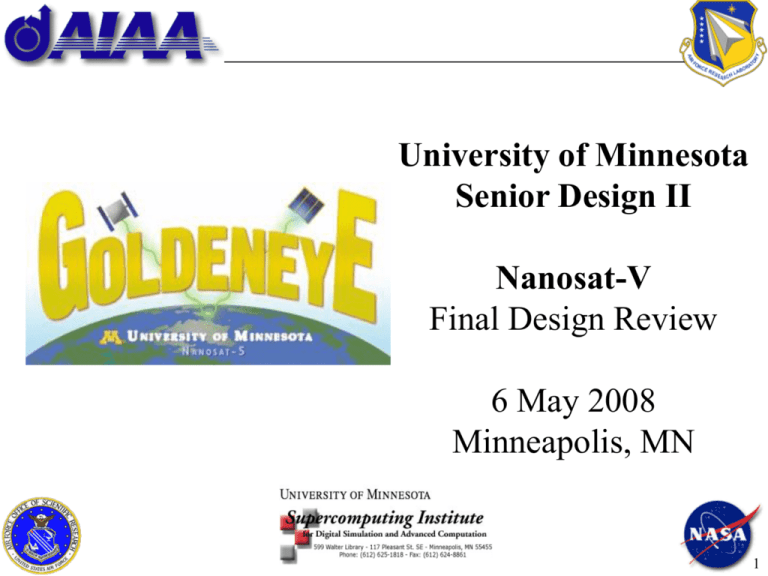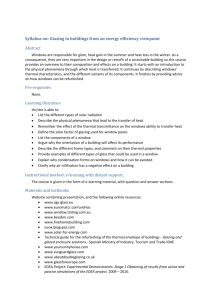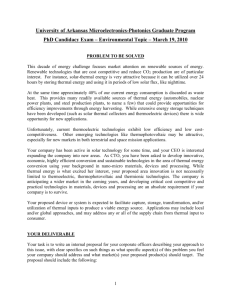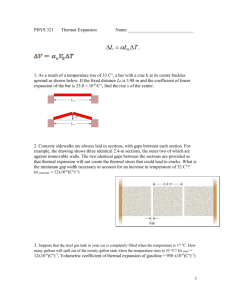Allowable Temperature Range (deg C)
advertisement

University of Minnesota Senior Design II Nanosat-V Final Design Review 6 May 2008 Minneapolis, MN 1 Project Objective • The aim of this project is to perform and validate thermal, structural and vibrational analyses on the Nanosat-5 satellite. • The tests will ensure that the vehicle is capable of withstanding loads, vibrations and temperatures, as specified by the University Nanosat Program. 2 Thermal Analysis (THRM) Subsystem Overview Thermal Analysis Team David Hauth Chuck Hisamoto Michael Legatt 3 Objectives of Thermal Analysis • Assemble list of material properties, temperature critical component profiles • Provide thermal models of Goldeneye with nodes for each of the temperature critical components onboard • Determine hot case and cold case thermal boundary conditions • Determine temperature history for each temperature critical component Component Box Placement • 3 component boxes Battery Box – 2 for electrical components • GPS Receiver, Radios, etc. – 1 dedicated for batteries • Strict requirements for coatings and narrower allowable temperature range • IMU • Flight Computer Component Boxes IMU Flight Computer 5 Thermal Analysis (THRM) David Hauth 6 Theory • Conventional heat transfer through three modes – Conduction – Convection – Radiation/Re-Radiation • Most significant means of transferring energy to spacecraft • Sources: – Solar Radiation » Sun radiates at black body temperature of 5777K » Mean flux of 1367 W/m^2 – Reflected Solar Radiation (Albedo) » Reflected and absorbed light accounts for 100% of energy received from sun » Dependent on ground cover » Goldeneye uses a table of average albedo for every 10 degrees of latitude – Earth IR Radiation » » » » Thermal equilibrium requires radiating energy equal to the amount absorbed Higher temperature bodies emit shorter wavelengths of energy Earth re-emits energy in the IR spectrum Goldeneye uses a table of average IR fluxes for every 10 degrees of latitude Analysis Input: Material Properties – Alodine Aluminum (6061 T6) • Thermal conductivity: • Specific Heat: • Absorptivity/emissivity: Solar: IR: 167 W/m2 896 J/kg-K .35 0.1 – Emcore Triple Junction GaAs Solar Cells • Annealed at 200 deg C • Absorptivity/emissivity: Solar: IR: .92 .89 – Nusil CV10-2568 Controlled Volatility RTV Ablative Silicone Adhesive • Operating Temperature Range (deg C): -115 to 240 8 Internal Power Generating Components Thermal Analysis Methodology 10 Thermal Analysis (THRM) Michael Legatt 11 Hot/Cold Orbits • • Which orbit is hottest, coldest? Heat Loads – Solar Flux – Cosmic Microwave Background Radiation – Internal Power Generation/Dissipation • –Earth Albedo –Earth Infrared Use Beta angle 12 Beta Angle Solar Eclipse begins at Betastar 13 Hot Case Occurs at: -Beta=Beta-star -Lowest altitude=250km Cold Case Occurs at: -Beta=0 -Highest altitude=1000 km 14 Thermal Boundary Conditions For each satellite face, MatLab/Simulink provides: • Earth IR flux and view factor • Earth Albedo flux and view factor • View Factor to Space MatLab Code Assumptions – – – – Fluxes are date/time, attitude, altitude, orbital position Earth Albedo, Earth IR latitude dependent Input time, RAAN, inclination, and altitude, attitude Solar Flux: 1327 – 1414 Watts/m2 15 Meshing Conditions • ANSYS auto-generates mesh based on input of element sizes – ANSYS picks element geometry type: octahedral (cube) or tetrahedral (pyramid) • Mesh size (approximate): ~1.0 cm • ~760,000 Nodes • Meshing Refinement – ~5 million nodes 16 Thermal Analysis (THRM) Chuck Hisamoto 17 Temperature Critical Components Component Operating Temperature [deg Celsius] Storage Temperature [deg Celsius] RTD Computer -20 to 70 -55 to 125 NovAtel GPS Receiver -40 to 85 -40 to 95 Kenwood TH-D7A radios -20 to 60 N/A SA-60C GPS antennas -40 to 85 -50 to 90 0 to 40 -30 to 50 American Power D150-15/5 power supply -25 to 85 -40 to 125 HG1700 Inertial Measurement Unit -30 to 60 -45 to 80 HMR2300 Three Axis Magnetometer -40 to 85 -55 to 125 Sanyo N-4000DRL batteries Worst Hot case, Sun side Allowable Temperature Range: -115 to 240 deg C Cells Annealed at 200 deg C Hot case, bottom Allowable Temperature Range: -115 to 240 deg C Hot case, warmer near Standoffs Allowable Temperature Range: -115 to 240 deg C Hot case, Isogrids, Standoffs Allowable Temperature Range: -115 to 240 deg C Hot case, Battery Box Allowable Temperature Range: 0 to 40 deg C Hot case, Component Box (Radio) Allowable Temperature Range: -20 to 60 deg C Hot case, Inertial Measurement Unit Allowable Temperature Range: -30 to 60 deg C Thermal Performance – Hot Case Component Satellite Solar Panels/Cells Actual Temperature Range Allowable Temperature Range Pass/ (deg C) (deg C) Fail Min Max Min Max -22.41 122.76 -115 Cells Annealed: 240 Pass 200 Battery Box 21.588 23.494 0 40 Pass Component Box (ADNCS, GPS, etc) 28.952 33.808 -40 85 Pass Component Box (Radios) 50.749 55.065 -20 60 Pass Flight Computer 55.281 58.769 -20 70 Pass IMU 44.647 46.555 -30 60 Pass 26 Thermal Performance – Cold Case Allowable Temperature Range: -115 to 240 deg C 27 Cold case, hot face/cold face Allowable Temperature Range: -115 to 240 deg C 28 Cold case, Isogrids/standoffs Allowable Temperature Range: -115 to 240 deg C 29 Cold case, Component Box (Radios) Allowable Temperature Range: -20 to 60 deg C 30 Cold case, Battery Box Allowable Temperature Range: -30 to 60 deg C 31 Thermal Performance – Cold Case Component Satellite Solar Panels/Cells Actual Temperature Range Allowable Temperature Range Pass/ (deg C) (deg C) Fail Min Max Min Max -35.329 29.645 -115 Cells Annealed: 240 Pass 200 Battery Box -19.982 -19.071 -30 50 Pass Component Box (ADNCS, GPS, etc) -14.388 -12.524 -40 85 Pass Component Box (Radios) -20.045 -17.584 -20 60 Fail Flight Computer -14.949 -14.442 -55 70 Pass IMU -17.539 -17.003 -40 85 Pass 32 Design Conclusions Hot Case Cold Case •All temperature critical components survive orbit within operating ranges •Heat accumulated on “hot side” -Satellite slow spin maneuver -Addition/changes to coatings •Radios component box is slightly out of storage temperature range. -Need for heaters -Small generation needed •All other components survive within range 33 Acknowledgements •Minnesota Supercomputing Institute -H. Birali Runesha, PhD., Director of Scientific Computing and Applications - Ravishankar Chityala, PhD., Scientific Development and Visualization Laboratory - Nancy Rowe, Scientific Visualization Consultant •Tom Rolfer, Honeywell International Inc. •Gary Sandlass, MTS Systems Corporation 34 Supporting Slides Follow 35 36 References • Bitzer, Tom. Honeycomb Technology. 1997. • Curtis, Howard. Orbital Mechanics for Engineering Students. 2005. • Gilmore, David (editor). Spacecraft Thermal Control Handbook. Vol.I. 2002. • Griffin, Michael and French, James. Space Vehicle Design. 2nd ed. 2004. • Kaminski, Deborah and Jensen, Michael. Introduction to Thermal and Fluids Engineering. 2005. • Modest, Michael. Radiative Heat Transfer. 2nd ed. 2003. 37 Supporting Slides-Task Breakdown • Selection of satellite structure geometry, materials, coating and isogrid patterns. • Design/modifications of body geometry 100% Complete • Design component locations/mounting 100% • Design torque coil mounting 100% • Body and housing material selection 100% • Selection of thermal coating 100% • Implement isogrid patterns 100% • Familiarization of software environment for analysis. • ProE 100% • Ansys 100% • Import methods 100% 38 Task Breakdown, cont’d. • Thermal analysis. • Receive determined component locations 100% Complete • Obtain relevant thermal constants 100% • Obtain relevant material properties 100% • Orbit propagation code for case determination 100% • Determine boundary conditions 100% • Generate thermal model for component heat sources 100% • Run simulations/verify results 50% 39 Supporting slides for mike 1 40 Satellite Structure GPS Direct Signal Antennas Solar Panels Lightband Interface High Gain Antenna 41 Supporting slides for mike/dave 2 42 Project Scope – Thermal • Provide thermal models of Goldeneye with nodes for each of the temperature critical components onboard • Provide complete list of heat sources and their profiles • Determine orbit hot and cold cases • For each component and at each node of the thermal models determine: – Operating temperature: Temperature at which the component will function and meet all requirements – Non-operating temperature: Component specifications are not required to be met. Component can be exposed in a power off mode. If turned to power on mode, damage must not occur – Survival temperature: Permanent damage to the component – Safety temperature : Potential for catastrophic damage 43 Thermal Analysis: Boundary Conditions Boundary Conditions: – Internal Heat Generation • • • • IMU – 9.7 Watts (operational) Computer – 9 -19 Watts Battery < 1 Watt Component Box 1 (ADNCS Microprocessor, Converter): – Cold: 1 Watt – Hot: 14 Watts • Component Box 2 (Radios) – Cold: 3 Watts – Hot: 26 Watts 44 Thermal Analysis: Future work ANSYS – Model is much to robust for computing resources – Need to simplify our analysis • Reduce node refinement at non-critical points • Eliminate re-radiation between some internal components: – Most likely from boxes to other boxes • Shorten time steps (length of analysis) – Currently doing 6 orbits – Analyze Thermal Results • Design changes if necessary – Test Convergence / Accuracy 45 Top Level Requirements Provide thermal histories for all temperature critical components under hot and cold worst cases. Requirement Number Requirement Type Verification Document Status THRM-1 Assemble list of material properties, temperature critical component profiles research GEN-ANA-0001_A verified THRM-2 Provide thermal models of Goldeneye with nodes for each of the temperature critical components onboard analysis GEN-ANA-0001_A verified THRM-3 Determine hot case and cold case thermal boundary conditions analysis GEN-ANA-0001_A verified THRM-4 Determine temperature history for each temperature critical component analysis GEN-ANA-0001_A verified Thermal Boundary Conditions -Heat Fluxes -Fluxes are date/time, attitude, orbit dependent use Simulink/M-files -Double quadruple integrals+ 832 lines=1.5 - 3 hrs run time per 1 orbit 47 Thermal Boundary Conditions - Albedo Boundary Conditions: -Fluxes are date/time, attitude, orbit – Solar Flux: 1327 – 1414 Watts/m2 – Earth Albedo – Earth IR Source: http://www.tak2000.com/data/planets/earth.htm Extracted from: Thermal Environments JPL D-8160 48 Hot case, Hot face Hot case, Component Box (GPS receiver, ADNCS, etc) Allowable Temperature Range: -40 to 85 deg C Hot case, Flight Computer Allowable Temperature Range: -20 to 70 deg C Cold case, Component Box: GPS, ADNCS, etc Allowable Temperature Range: -40 to 95 deg C 52 Cold case, Flight Computer Allowable Temperature Range: -55 to 125 deg C 53 Cold case, IMU Allowable Temperature Range: -40 to 85 deg C 54






